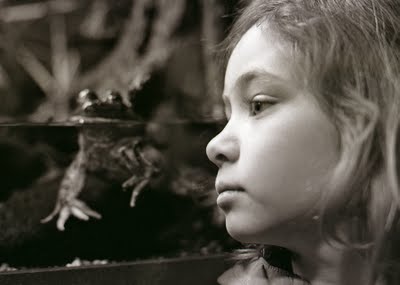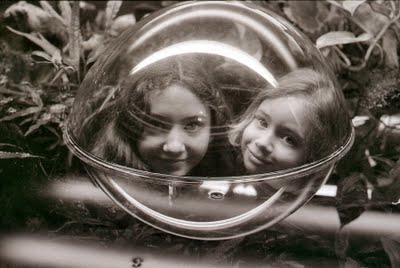Nightingale's Vancouver Aquarium - The Real Thing
Sunday, February 07, 2010

In 1975 when we arrived to Vancouver from Mexico one of the most ubiquitous bumper sticker and car rear window adornments featured a beautifully stylized killer whale in black, white, blue and silver. I immediately purchased my own and took Rosemary and my two daughters Ale and Hilary to the Vancouver Aquarium. In 1975 I smoked cigars and a pipe, thought women in high heel shoes were sexy and bought Playboy almost on a monthly basis.
The Planetarium was another Vancouver icon which we visited with regularity. I was in love with a city which featured mountains, water, bridges and what seemed to be booming museums. At the Maritime Museum I was thrilled by a tour of the RCMP ship the St Roch.
I had had enough of baroque churches and Mexican museums that smelled of antiquity. I was ready for the new, the modern. I was ready for Vancouver.
Slowly over the years I gave up smoking, thought high heeled shoes as devices that made women look ungainly and unbalanced and (yes) unsexy. I stopped reading Playboy. I became blind to the mountains, the water and the bridges except on those sunny days after weeks of gray and rain. I must admit (and this may be the real problem behind the low popularity of the Maritime Museum) that I never feel I am near the sea. I don’t hear or see waves nor do I smell the ubiquitous salt air of a port city such as Veracruz where lived for some years. I became a Vancouverite.
Ale and Hilary, Rosemary and I all enjoyed the thrill of the killer whale show at the Vancouver Aquarium. We never thought of them as being caged animals. It is only of late that I have come to understand (and almost sympathize) with the public relations problem that John Nightingale, the director of the Vancouver Aquarium has and seems to have reduced with a good measure of dogged effort on his part.
In some way I am proud (or at the very least find it significant) that my Rebecca “suffered” the pleasure of being splashed by the huge tail of a killer whale at the Vancouver Aquarium. We went to see one of the last shows before the whales were released or sent to other aquariums. The staid presence of the belugas now seems like watching clowns with painted white faces performing in slow motion in comparison to the excitement of the killer whales.
Is it only a matter of time before the pushed-into-a-corner Nightingale will have to defend the dolphin show. My granddaugther Lauren, 7, declared the dolphin show her favourite experience at the aquarium. Considering that, if anything, dolphins may be smarter than orcas and the presence of the two very cute sea otters who must be every much as intelligent as the pacific octopus I see trouble ahead. Will the aquarium some day feature, and, only feature small tropical fish and sea urchins with one or two sharks that people still manage to hate/love but without anthropomorphizing them into cuteness?
As an idealistic 21 year-old I remember believing that all in the world was black or white and could be reduced to either of both extremes. A slightly older and wiser friend told me that the world was mostly gray. Like my wise friend I see few things now as either black or white.
In a couple of early William Gibson novels, Gibson has a father and son entering a mall where the sons asks something like, “Dad what’s that?” and points to a display on a pedestal. The father replies, “That’s a stuffed horse.” It would seem that Gibson is predicting that someday we will no longer have horses and our memory of them will only be refreshed by the presence of a stuffed specimen.
Three years ago Rebecca, Rosemary and I visited Mexico’s largest zoo which is in Morelia in the state of Michoacán in Mexico. Because of its size, most animals seem to have space to move. When Rebecca spotted a raccoon in a small cage she noted that the animal was turning back in forth with the obsessive movement of an animal that is really caged. She grew angry and felt sad for the animal. Moments later we witnessed in a large compound full of African ostriches, two giraffes running one after the other. It was sheer ballet movement. The grace of these animals was a sight to relish, their necks seemed to follow the pattern of sine waves, with a slight out of phase but similar movement from their legs. When they finally stopped running around after what seemed like a long time, we looked at each other and realized we had experienced something unique.
The question I have for which I do not have a black and white answer is: Can we justify having a couple of cute sea otters in an aquarium so that their image for my granddaughters will not only be the image on a computer monitor? Do they have to experience a real zebra to experience a real zebra? I think I would now answer that affirmatively.
At age 12 Rebecca seemed to know more about the fish and sea animals at the aquarium than Rosemary and I did. She knew all about the belugas and their two offspring (even their names). Rebecca noted how rare this was and how lucky we were to have this happen in Vancouver. Her information has come from the net, school textbooks, magazines, good documentaries and a very important and well organized class trip to the aquarioum. Is all that enough?
My initial response is no. You need the real thing. But then the Vancouver Aquarium at the very least has specimens that are living. They are the real thing from the tiny little red frog that wowed Rebecca to the dolphins that delighted Lauren.
Because I was raised as a Roman Catholic, I can assert that up to about 20 years or so ago I would have told anyone that I had no doubt about the relationship that we humans had with the "lower orders". God had put the animals, the fishes (and even those mosquitoes) for us to lord over and to do with them as we saw fit. We were the humans. We have a soul.
It is only in the last few years that more and more of us (or at least this sort of former Roman Catholic) have modified that ever so selfish opinion that we were the kings of the earthly castle to the idea that we are on this planet together, including those pesky slugs and cutworms that eat my hostas.

It was Brother Edwin who told us in our St. Ed’s High School theology class that even if Hitler were deemed to be a monster we still had to respect his humanity simply by the fact that he had been chosen by God to be born as a man. “There is an inherent human dignity in all of us,” Brother Edwin would often tell us. I have now modified that and extend it even to those garden pests. We are all in this together.
It was with all the above contradictions that I gingerly entered the Vancouver Aquarium yesterday. Our guide was Rebecca who pretty well directed us from here to there with a luxury of relevant information on what we saw. She seemed to know a lot about the frogs. I had to remind her that one sight that would be absent was a South American (I believe that it was South American.) baby alligator that we had seen when she was 4 and 5. The alligator was a startling cream, yellow and brown. For close to a year when Rebecca would misbehave I would make or threaten to make phone calls to the señor crocodilo as Rebecca called the cocodrilo (Spanish for crocodile). Rebecca smiled and smiled again when she pointed to the entrance to the 4-D film. These are BBC 3-D Planet Earth documentaries in which you are gently misted with water (when whales splash) or feel vibrations under your seat when certain sea animals discharge electricity, etc. This was a thrilling experience. All in all, the aquarium seemed less a museum, less an aquatic zoo, and more an experience that caught the attention of even the most special-effects-blasé kid. This experience might even push a few of these children into more exploration; an exploration into the real thing, perhaps?
It would seem to me that under the tutelage of John Nightingale, our Vancouver Aquarium is relevant in a most active way and I can only applaud the man who has stayed, through thick and thin, when others would have moved on.






